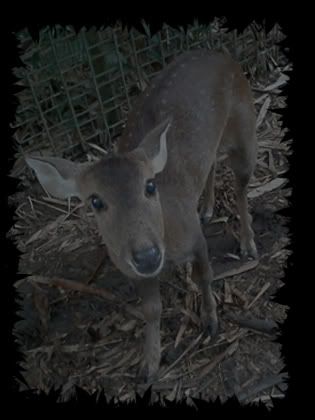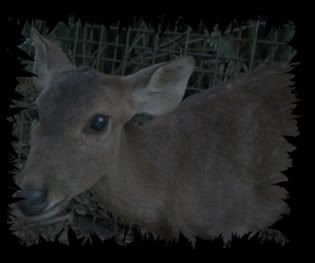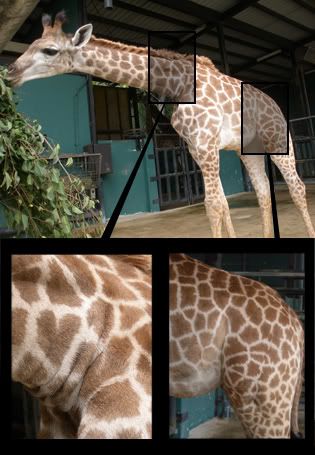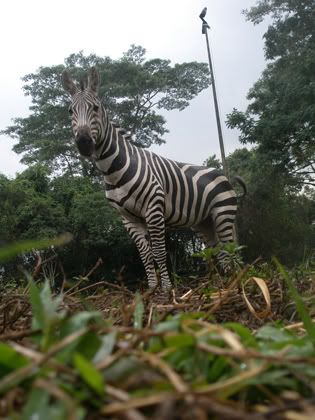theappletree
Seed then apple
school of apples
Passionately red
Youthfully green
Crunch crunch
Yummy
showcasing, youths passionately
now together with mummies and daddies =D
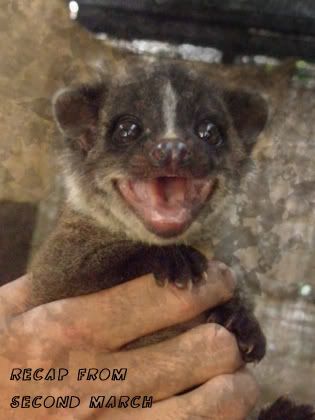
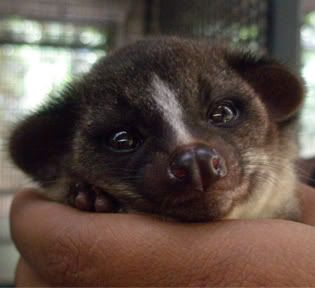
Recaping back : 2ndMarch's post. I promised i'll initroduce them properly. And here i am again. A promise is a promise. The 1st and 2nd photo showed this babeh girl, still less than a month old.
And here are the adults. Not sure though, if the daddy is inside. But well...
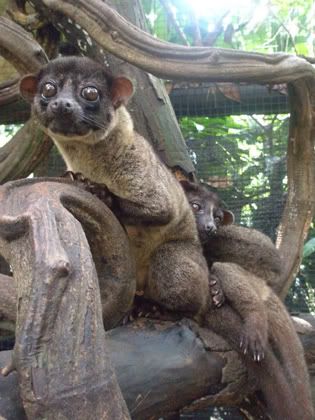
Small toothed Palm Civet
Arctogalidia trivirgata
also known as the Three-striped Palm Civet
Kingdom: Animalia
Phylum: Chordata
Class: Mammalia
Order: Carnivora
Family: Viverridae
Gestation period : 45 days
Litters per year : 2
Lifespan : 11 years
Average litter size : 3
Young open their eyes at 11 days and
weaned at two months
no set mating season
solitary, arboreal (very) and nocturnal
The diet is varied and omnivorous, and usually consist of insects, small mammals, nesting birds, fruits, frogs and lizards.
_________________________________________________
Cute litter fellows. And definitely are not any bigger a different to hungry zombies when you're in their habitat with food. They climbed around you, on you and... yea. everywhere around you. Strokie strokie ^^
_________________________________________________
Next up, freshly born and flopped
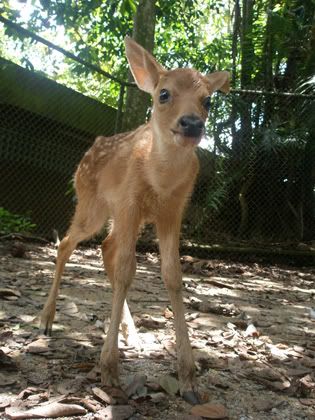
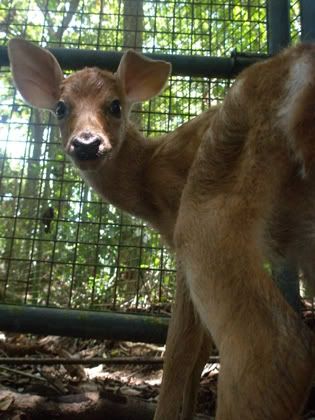
Behold! A barasingha babeh >< Kyaaaa~ First barasingha fawn ive seen. Superb fellow. And unusually long, long hing legs and a uniquely flopped left ear Kyaaaa ><
Floppy floppie floppiiie. Kawaii~~~ Kya.
Oh. And the adults. Ya ya.
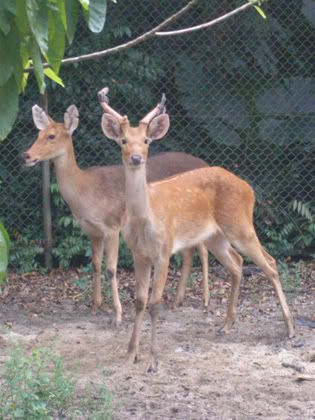
Barasingha
Rucervus duvaucelii
Kingdom: Animalia
Phylum: Chordata
Class: Mammalia
Order: Artiodactyla
Family: Cervidae
The breeding season : September to April
Gestation period : 240-250 days in August to November
Average litter size : 1
Lifespan : 20yrs (wild), 23 yrs (captive)
Sexual maturity : 2 yrs (female)
Fawn weaned at 6 to 8 months of age
native to India and Nepal
When alarmed they give out a shrill baying alarm call.
Barasingha are polygynous, a dominant stag collecting a harem of up to thirty hinds (females). He will fight with other males for possession of the harem and the right to breed. However, congregations of up to 250 individuals have been seen
Most striking feature of a barasingha is its antlers, with 10-14 tines on a mature stag, though some have been known to have up to 20.
The name is derived from this and means 12 tined or horned in Hindi.
_________________________________________________
Ah~ love this little guy too, too much. Wrap him up for me please and i shall bring him home laterrr. Kya >< Grow up well.
_________________________________________________
Have been getting a great numbers of night shifts and thus have spent much time observing the furries in the dark. And managed to, luckily, chance upon this spectacular image. Bravotic lighting and stunning posture by the kitty ^^
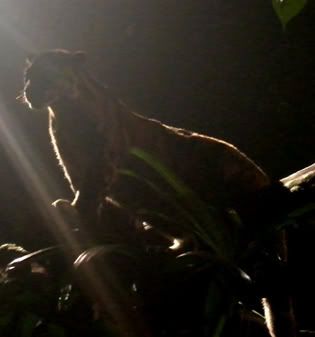
Well, many may wonder. How exactly do they looked like. Even if you had been to the Night Safari, the lightings are regrettably poor and dim. Pretty fur coats and patterns are often not display clearly. Thus! Attached, a clear shot of our pretty Clouded Leopard - Taya. Be amazed =)
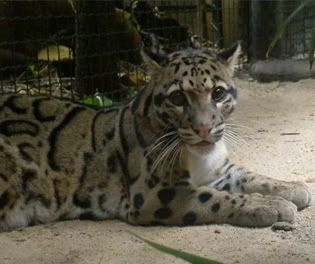
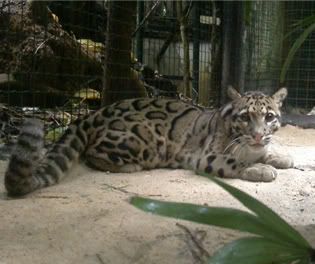
Clouded Leopard
Neofelis nebulosa
Kingdom: Animalia
Phylum: Chordata
Class: Mammalia
Order: Carnivora
Family: Felidae
Gestation period : 85 - 93 days
Average litter size : 1 - 5 cubs
Sexual maturity : 2 yrs of age
Litters per year : 1
Lifespan : 11yrs (average), 17yrs (max)
Young can see within about 10 days of birth, are active within 5 weeks, and probably become independent at about 10 months of age
The Clouded Leopard, despite its name, is not closely related to the Leopard. The Clouded Leopard is regarded as a monotypic genus
Large build and, proportionately, the longest canine teeth (2 in, about the same as a tiger's) of any living feline
_________________________________________________
Am in the process of becoming a good friend of the cloudies. Strokie strokie =)
_________________________________________________
Hmm. What else. Ah ha. Bonus picture of the day :
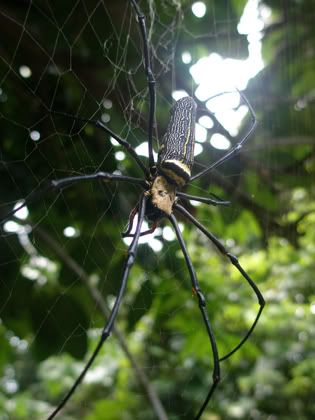
This. is a gigantic spider. Real huge. Size of my palm to finger. About 16cm from its' tip to tip. Real beauty. Not too sure about the species of this crawlie but ive been told this is the female. The male, is actually way smaller. Smaller than the female's head. Now, what kind of comparison is that. Amazed, yet again. I am.
_________________________________________________
Well, a whole load of info today. So let's close our eyes and get some sleep. Soon.
10 + 10 + 10 + 10 Lalalalala
school of apples
Passionately red
Youthfully green
Crunch crunch
Yummy
showcasing, youths passionately
now together with mummies and daddies =D


Recaping back : 2ndMarch's post. I promised i'll initroduce them properly. And here i am again. A promise is a promise. The 1st and 2nd photo showed this babeh girl, still less than a month old.
And here are the adults. Not sure though, if the daddy is inside. But well...

Small toothed Palm Civet
Arctogalidia trivirgata
also known as the Three-striped Palm Civet
Kingdom: Animalia
Phylum: Chordata
Class: Mammalia
Order: Carnivora
Family: Viverridae
Gestation period : 45 days
Litters per year : 2
Lifespan : 11 years
Average litter size : 3
Young open their eyes at 11 days and
weaned at two months
no set mating season
solitary, arboreal (very) and nocturnal
The diet is varied and omnivorous, and usually consist of insects, small mammals, nesting birds, fruits, frogs and lizards.
_________________________________________________
Cute litter fellows. And definitely are not any bigger a different to hungry zombies when you're in their habitat with food. They climbed around you, on you and... yea. everywhere around you. Strokie strokie ^^
_________________________________________________
Next up, freshly born and flopped


Behold! A barasingha babeh >< Kyaaaa~ First barasingha fawn ive seen. Superb fellow. And unusually long, long hing legs and a uniquely flopped left ear Kyaaaa ><
Floppy floppie floppiiie. Kawaii~~~ Kya.
Oh. And the adults. Ya ya.

Barasingha
Rucervus duvaucelii
Kingdom: Animalia
Phylum: Chordata
Class: Mammalia
Order: Artiodactyla
Family: Cervidae
The breeding season : September to April
Gestation period : 240-250 days in August to November
Average litter size : 1
Lifespan : 20yrs (wild), 23 yrs (captive)
Sexual maturity : 2 yrs (female)
Fawn weaned at 6 to 8 months of age
native to India and Nepal
When alarmed they give out a shrill baying alarm call.
Barasingha are polygynous, a dominant stag collecting a harem of up to thirty hinds (females). He will fight with other males for possession of the harem and the right to breed. However, congregations of up to 250 individuals have been seen
Most striking feature of a barasingha is its antlers, with 10-14 tines on a mature stag, though some have been known to have up to 20.
The name is derived from this and means 12 tined or horned in Hindi.
_________________________________________________
Ah~ love this little guy too, too much. Wrap him up for me please and i shall bring him home laterrr. Kya >< Grow up well.
_________________________________________________
Have been getting a great numbers of night shifts and thus have spent much time observing the furries in the dark. And managed to, luckily, chance upon this spectacular image. Bravotic lighting and stunning posture by the kitty ^^

Well, many may wonder. How exactly do they looked like. Even if you had been to the Night Safari, the lightings are regrettably poor and dim. Pretty fur coats and patterns are often not display clearly. Thus! Attached, a clear shot of our pretty Clouded Leopard - Taya. Be amazed =)


Clouded Leopard
Neofelis nebulosa
Kingdom: Animalia
Phylum: Chordata
Class: Mammalia
Order: Carnivora
Family: Felidae
Gestation period : 85 - 93 days
Average litter size : 1 - 5 cubs
Sexual maturity : 2 yrs of age
Litters per year : 1
Lifespan : 11yrs (average), 17yrs (max)
Young can see within about 10 days of birth, are active within 5 weeks, and probably become independent at about 10 months of age
The Clouded Leopard, despite its name, is not closely related to the Leopard. The Clouded Leopard is regarded as a monotypic genus
Large build and, proportionately, the longest canine teeth (2 in, about the same as a tiger's) of any living feline
_________________________________________________
Am in the process of becoming a good friend of the cloudies. Strokie strokie =)
_________________________________________________
Hmm. What else. Ah ha. Bonus picture of the day :

This. is a gigantic spider. Real huge. Size of my palm to finger. About 16cm from its' tip to tip. Real beauty. Not too sure about the species of this crawlie but ive been told this is the female. The male, is actually way smaller. Smaller than the female's head. Now, what kind of comparison is that. Amazed, yet again. I am.
_________________________________________________
Well, a whole load of info today. So let's close our eyes and get some sleep. Soon.
10 + 10 + 10 + 10 Lalalalala
